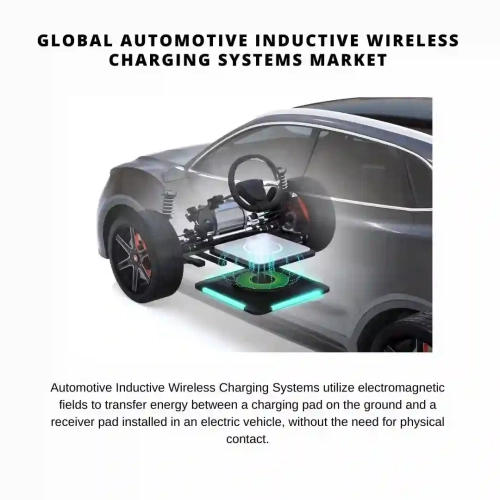
- Get in Touch with Us

Last Updated: Apr 25, 2025 | Study Period: 2024-2030
The Global Automotive Inductive Wireless Charging Systems Market is poised for significant growth over the next six years, driven by several key factors. The increasing adoption of electric vehicles (EVs) is a major driver, as wireless charging offers a convenient and user-friendly solution compared to traditional plug-in charging.
Government regulations promoting EV adoption and investments in charging infrastructure are further accelerating the market. Additionally, the rising consumer preference for comfort and technological advancements in vehicles is fueling demand for wireless charging systems.
The technology itself is undergoing advancements. Improved efficiency and power transfer capabilities are making inductive charging a more viable option for EVs with larger batteries. Standardization efforts are also underway to ensure compatibility between different car models and charging systems.

However, challenges remain. The higher cost of implementing wireless charging systems compared to traditional methods is a hurdle. Technical limitations such as lower charging speeds and alignment sensitivity also need to be addressed.
The Asia Pacific region is expected to dominate the market due to the strong presence of major EV manufacturers and government initiatives promoting clean energy solutions. Europe and North America are also anticipated to witness significant growth, driven by rising EV sales and supportive regulatory frameworks.
The market for automotive inductive wireless charging systems is expected to witness the entry of new players alongside established automotive component manufacturers. This competition will drive innovation and potentially lead to more affordable and efficient charging solutions. Strategic partnerships between automakers, charging infrastructure providers, and technology companies are likely to play a crucial role in the development and deployment of wireless charging systems.
Looking ahead, the focus will be on developing advanced in-road charging systems that enable EVs to be charged while driving. This technology holds immense potential for the future of electric mobility. Overall, the global automotive inductive wireless charging systems market presents a promising outlook for the coming years. As technology advances and infrastructure expands, wireless charging is poised to become a mainstream solution for EV charging, enhancing convenience and driving the adoption of electric vehicles.
Inductive wireless charging systems for automotive applications represent an innovative technology aimed at simplifying the charging process for electric vehicles (EVs) by eliminating the need for physical cable connections. Inductive wireless charging systems utilize magnetic coils installed in both the vehicle and the charging pad (often embedded in the ground or a fixed location). When the vehicle is parked over the charging pad, an electromagnetic field is created, inducing an electric current in the coils of the vehicle, which then charges the battery.
Modern inductive charging systems aim for high efficiency to minimize energy losses during charging. Efficiency rates above 90% are common, ensuring effective transfer of energy from the charging pad to the vehicle's battery.Inductive wireless charging systems vary in power capacity, ranging from lower capacities suitable for overnight home charging (typically 3.5 kW to 11 kW) to higher capacities (up to 22 kW or more) for fast charging in public settings.Manufacturers are working towards standardizing inductive charging systems to ensure compatibility across different vehicle models and charging infrastructure providers. This includes addressing variations in power requirements, coil sizes, and communication protocols.
The market for automotive inductive wireless charging systems is witnessing rapid growth driven by the expanding adoption of electric vehicles (EVs) globally. These systems are revolutionizing the EV charging landscape by offering a convenient and cable-free alternative to traditional plug-in charging methods. Inductive wireless charging works on the principle of electromagnetic induction, where energy is transferred from a ground-based charging pad to a receiver coil installed on the vehicle, enabling efficient and seamless charging without physical contact.
Key factors fueling market growth include increasing government initiatives to promote electric vehicle adoption, rising consumer demand for convenient charging solutions, and advancements in charging technology aimed at improving efficiency and reducing charging times. Manufacturers are focusing on enhancing the power capacity of inductive charging systems to accommodate fast charging needs, making them suitable for a wide range of EVs from passenger cars to commercial vehicles.
However, challenges such as the high initial cost of infrastructure deployment, interoperability issues between different charging systems, and the need for standardization across regions remain significant hurdles. Despite these challenges, the automotive inductive wireless charging market is poised for significant expansion as stakeholders invest in research and development to overcome technological barriers and capitalize on the growing demand for sustainable transportation solutions

The Global Automotive Inductive Wireless Charging Systems Market is seeing robust growth across various regions, with Asia-Pacific at the forefront due to rapid industrialization and extensive infrastructure projects. Significant contributions to market demand also come from North America and Europe, driven by advancements in construction and manufacturing sectors. Over the next few years, the market is expected to expand steadily, supported by both industrial and consumer sectors. However, challenges such as regulatory impacts, economic uncertainties, and market dynamics pose risks. Yet, the industry's ability to adapt to regulatory shifts and innovate amid evolving market conditions underpins its resilience.
| Sl No | Company | Product Description | Analyst View |
| 1. | MAHLE | MAHLE introduced its Differential Inductive Positioning System (DIPS) as the global standard for wireless charging in electric and hybrid vehicles. SAE International's adoption of MAHLE's technology closed a long-standing standardization gap, enabling rapid market deployment. DIPS streamlined the charging process by automating vehicle alignment over the charging coil, ensuring convenience and reliability in various environmental conditions. This innovation marked a significant advancement in e-mobility, offering a cable-free alternative with universal compatibility across manufacturers through a FRAND licensing model. | DIPS simplified the charging process by automatically aligning vehicles over the charging coil, ensuring ease and reliability even in challenging conditions like snow or wet surfaces. This development represented a major leap forward in e-mobility, providing a universal, cable-free solution accessible to all manufacturers through a fair and non-discriminatory licensing approach. |
| 2. | VALEO | Valeo introduced the Ineez Air Charging system, a lightweight and efficient inductive wireless EV charging technology. This solution, 50% lighter than competitors, ensured 93% grid-to-battery efficiency and compatibility with various home and workplace environments. With 25 patents covering hardware and software, Valeo enabled seamless integration with all vehicle types and V2G systems, despite operating at 3 kHz rather than the standard 85 kHz. Designed for simplicity and cost-effectiveness, Ineez Air Charging aimed to appeal to residential and fleet markets, offering convenience and flexibility for electric vehicle owners worldwide. | This innovative system, lighter by 50% compared to competitors, boasts a high efficiency rate of 93% from grid to battery. With 25 patents covering hardware, software, and mechatronics, Valeo ensures compatibility across all home charging setups and vehicle types, including V2G systems. Despite operating at 3 kHz instead of the industry-standard 85 kHz, this solution prioritizes simplicity and cost-effectiveness, aiming to streamline the charging experience for residential and fleet applications worldwide. |
| 3. | TU Braunschweig and INTIS GmbH | TU Braunschweig and INTIS GmbH collaborated on developing a 22 kW stationary inductive charging system for electric vehicles, achieving significant milestones in the inductive wireless charging sector. This system operates without cable connections, using magnetic coils to transfer energy from the road surface to the vehicle's battery via power electronic circuits. Extensive testing, conducted at the IMAB and elenia Institute, validated the system's functionality and safety, culminating in successful integration with a VW e-Crafter as a test vehicle at INTIS in Lathen, Emsland. | This innovative system eliminates the need for cable connections by leveraging magnetic coils to transmit energy from the road surface to the vehicle's battery through sophisticated power electronic circuits. Rigorous testing and validation, conducted at the IMAB and elenia Institute, ensured the system's reliability and safety. The successful integration with a VW e-Crafter test vehicle at INTIS in Lathen, Emsland, underscores its practical application and readiness for future deployment. |
In the automotive inductive wireless charging systems market, leading firms are strategically deploying initiatives like product innovation, partnerships, and mergers and acquisitions to strengthen their market foothold. Significant investments in research and development are geared towards developing cutting-edge, efficient, and user-friendly charging solutions tailored for diverse vehicle applications.
Intense price competition compels manufacturers to strike a delicate balance between enhancing product quality and ensuring cost-effectiveness. This competitive environment fosters differentiation through technological advancements and the integration of value-added features. Moreover, strategic alliances and acquisitions are pivotal in expanding market presence and diversifying product portfolios to meet evolving industry demands.
| Sr. No | Topic |
| 1 | Market Segmentation |
| 2 | Scope of the report |
| 3 | Research Methodology |
| 4 | Executive Summary |
| 5 | Average B2B by price |
| 6 | Growth Drivers for automotive inductive wireless charging systems market |
| 7 | Key Constraints for automotive inductive wireless charging systems market |
| 8 | Market Size, Dynamics, and Forecast by Geography, 2024-2030 |
| 9 | Market Size, Dynamics, and Forecast by Technological Type, 2024-2030 |
| 10 | Market Size, Dynamics, and Forecast by Vehicle Type, 2024-2030 |
| 11 | Market Size, Dynamics, and Forecast by Application, 2024-2030 |
| 12 | Competitive landscape |
| 13 | Market share of vendors, 2023 |
| 14 | Company Profiles |
| 15 | Conclusion |
| 16 | Key Innovations and New Product Launches |
| 17 | Strategic Partnerships and Collaborations |
| 18 | Investment Opportunities and Market Entry Strategies |
| 19 | Analysis of Regulatory Impact on the Market |
| 20 | Impact of Technological Advancements |
| 21 | Market Trends and Future Outlook |
| 22 | Analysis of Customer Demand and Preferences |
| 23 | SWOT Analysis of Key Players |
| 24 | Case Studies of Key Players |
| 25 | Recommendations for Stakeholders |
| 26 | Distribution Channels and Sales Analysis |